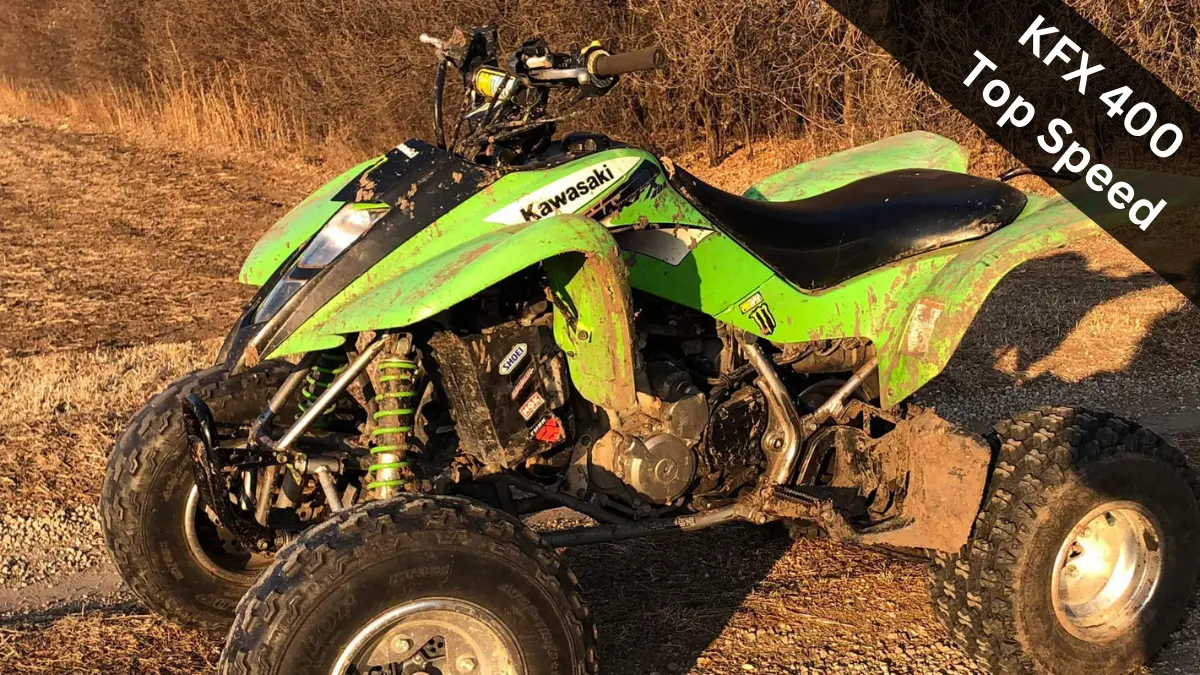If you were part of the ATV racing scene during the early 2000’s, there’s a pretty good chance you either won with or lost to a Kawasaki KFX 400 at some point.
The KFX 400 came along in 2003 and was one of the go-to sport ATVs for those into sport riding or who simply wanted to ride one of the fastest ATVs available at the time.
While they eventually gave way to the faster 450cc class, there are still plenty of KFX 400 models burning rubber in the wild today.
So how fast does the Kawasaki KFX 400 go? This guide will review the KFX 400 top speed and several ways to increase it.
Kawasaki KFX 400 Top Speed
Powered by a 398cc single cylinder engine with a maximum output of around 32 horsepower, the KFX 400 top speed is 70 mph for those models in stock condition.
However, many owners have made modifications to their stock units that result in a top speed closer to 85 mph.
These modifications include:
- Upgrading the intake system
- Upgrading the exhaust system
- Re-jetting the carburetor
- Increasing the gearing
Let’s explore each of these modifications and the most highly recommended aftermarket parts to achieve that 85 mph top speed in the KFX 400.
KFX 400 Intake Upgrade
The more air you supply to the engine, the more power and speed it will be able to generate.
For more air in, owners should consider upgrading their air intake system, which consists of the airbox and air filter.
Doing this should result in more horsepower and torque at higher RPM ranges, which translates to more top-end speed.
The following are some of the highest-recommended aftermarket air intake upgrades for the KFX 400:
- Sparks Racing
- Barker’s EHS
- Duncan Racing
- K&N Filters
Each of these upgrades will increase the air supply to your engine. But you’ll also need to provide this added airflow with an efficient exit once used up, which is where upgrading the exhaust system comes in.
KFX 400 Exhaust Upgrade
By upgrading the exhaust, you’ll complete the back half of the added airflow cycle by providing an efficient escape for the increased airflow into the engine.
This helps to increase the horsepower and torque at all RPM levels.
An upgraded exhaust system will also improve the sound of your quad. But there’s a tradeoff here as it will also increase the sound, with most aftermarket exhaust systems upping the sound output by around three to six decibels.
Among the highest recommended aftermarket exhaust systems for the KFX 400 are:
- Empire Exhaust
- HMF Exhaust
- Sparks Racing Exhaust
- Barker’s Exhaust
Each of them vary in style and sound, but provide about the same increase in performance.
For a side by side comparison of each, check out this Aftermarket Exhaust Guide.
Re-jetting The Carburetor
In order to maintain the optimal air to fuel ratios, you’ll need to increase the fuel flow as well to account for the increase in airflow from the upgraded intake and exhaust systems.
To increase the fuel flow in the KFX 400, you’ll need to re-jet the carburetor by replacing or adjusting the three different jets within it.
Both the pilot jet and the main jet will need to be replaced with bigger jet sizes, while the needle jet can simply be adjusted by rotating it.
The ideal jet replacement sizes for the pilot and main jet will depend upon the specific types of intake and exhaust modifications you’ve done.
And these replacements usually take some trial and error to determine which jets will result in your machine running best.
That said, while you can purchase jet kits, you’re likely better off purchasing a few different jet sizes and swapping them out until you find the best fit.
Increase The Gearing
The KFX 400 is equipped with a 14-tooth front sprocket and 40-tooth rear sprocket in stock form.
If you want to increase the top end speed, you should make a change to a slightly bigger front sprocket and slightly smaller rear sprocket.
For the KFX 400, moving to a 15-tooth front sprocket and 38 or 39-tooth rear sprocket should give you more top-end speed.
But there will be a tradeoff here, as your acceleration and low-end torque will decrease some as a result of this change.
Conversely, moving to a 12-tooth front sprocket and 42 or 44-tooth rear sprocket will result in more low-end torque and acceleration for your KFX 400.
MORE: Kawasaki Brute Force 750 Top Speed
Other Ways To Increase KFX 400 Top Speed
Bigger Tires
The KFX 400 is equipped with 22 inch Dunlop stock tires in the front and 20 inch Dunlop stock tires in the rear.
If looking for more speed, increasing to 23-inch tires up front and 21 or 22 inch tires in the rear will help.
Ensure Proper PSI In Tires
Underinflated tires will lead to less top-end speed, so ensure your tires are inflated to the proper PSI to maximize performance.
The KFX 400 owner’s manual recommends 4 PSI in the front stock tires and 5 PSI in the rear stock tires.
Use High Octane Fuel
If you’re not already using 91 or 93 octane fuel, it is recommended for a variety of different reasons.
One of those being that the KFX 400 simply performs better when using high octane fuel.
You’ll definitely be able to tell a difference in high octane vs lower octane fuel in the way your vehicle performs, including its speed.
Conclusion
For its class, the KFX 400 is still one of the faster ATVs in the industry with units in stock condition topping out at 70 mph.
But with a few modifications, this model can hit upwards of 85 mph.
If you’re in the market for an ATV that can haul, check out the following guides before you hit the road:


